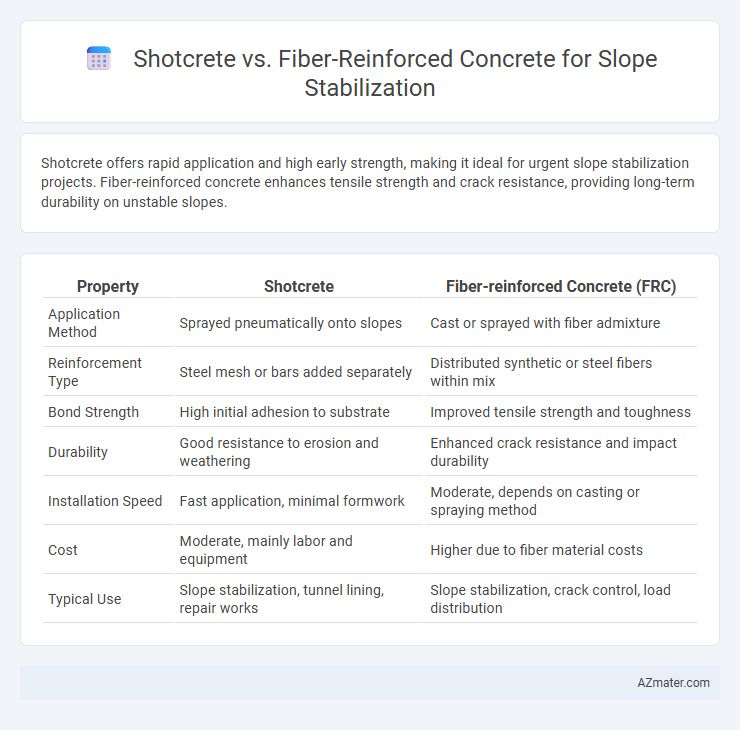Shotcrete offers rapid application and high early strength, making it ideal for urgent slope stabilization projects. Fiber-reinforced concrete enhances tensile strength and crack resistance, providing long-term durability on unstable slopes.
Table of Comparison
| Property | Shotcrete | Fiber-reinforced Concrete (FRC) |
|---|---|---|
| Application Method | Sprayed pneumatically onto slopes | Cast or sprayed with fiber admixture |
| Reinforcement Type | Steel mesh or bars added separately | Distributed synthetic or steel fibers within mix |
| Bond Strength | High initial adhesion to substrate | Improved tensile strength and toughness |
| Durability | Good resistance to erosion and weathering | Enhanced crack resistance and impact durability |
| Installation Speed | Fast application, minimal formwork | Moderate, depends on casting or spraying method |
| Cost | Moderate, mainly labor and equipment | Higher due to fiber material costs |
| Typical Use | Slope stabilization, tunnel lining, repair works | Slope stabilization, crack control, load distribution |
Introduction to Slope Stabilization Techniques
Slope stabilization techniques are critical in preventing soil erosion, landslides, and structural failures in vulnerable terrains. Shotcrete, applied as a sprayed concrete layer, offers rapid setting and strong adhesion to slopes, effectively reducing surface erosion and promoting stability. Fiber-reinforced concrete enhances slope resilience by integrating synthetic or steel fibers that improve tensile strength and crack resistance, making it ideal for long-term durability under dynamic environmental conditions.
Understanding Shotcrete in Slope Stabilization
Shotcrete is a sprayed concrete method that enhances slope stabilization by providing immediate surface reinforcement and reducing erosion risks. It involves the application of a cementitious mixture projected at high velocity onto slopes, creating a dense, durable protective layer that adheres strongly to irregular surfaces. This technique improves structural integrity, controls soil movement, and is often reinforced with mesh or fibers to increase tensile strength and crack resistance in slope stabilization projects.
Overview of Fiber-Reinforced Concrete
Fiber-reinforced concrete (FRC) enhances slope stabilization by integrating synthetic or steel fibers that improve tensile strength, crack resistance, and durability. Its application reduces maintenance costs and mitigates erosion by providing a more flexible and impact-resistant surface compared to traditional shotcrete. The distribution and orientation of fibers within the concrete matrix ensure improved performance under dynamic load conditions typical in slope environments.
Key Material Properties and Performance
Shotcrete offers excellent adhesion and rapid application for slope stabilization, exhibiting high early strength and durability, while fiber-reinforced concrete enhances tensile strength, crack resistance, and ductility through dispersed fibers such as steel, glass, or synthetic materials. The incorporation of fibers significantly improves impact resistance and controls shrinkage cracking, making fiber-reinforced concrete more flexible under dynamic loads compared to traditional shotcrete. Optimal slope stabilization often requires balancing shotcrete's quick setting and bonding capabilities with fiber-reinforced concrete's superior toughness and long-term performance characteristics.
Installation Process: Shotcrete vs. Fiber-Reinforced Concrete
Shotcrete installation involves spraying concrete pneumatically at high velocity onto the slope, enabling rapid application on uneven surfaces with immediate adhesion and minimal formwork. In contrast, fiber-reinforced concrete requires conventional placement methods such as pouring or pumping, combined with mixing synthetic or steel fibers into the concrete to enhance tensile strength and crack resistance post-application. Shotcrete offers faster slope stabilization owing to its quick setting and thin-layer application, while fiber-reinforced concrete provides improved long-term durability through integrated reinforcement within standard concrete placement.
Cost Comparison and Project Economics
Shotcrete offers a cost-effective solution for slope stabilization by providing rapid application and reduced labor expenses compared to traditional fiber-reinforced concrete, which involves higher material and mixing costs due to fiber additives. Fiber-reinforced concrete enhances durability and crack resistance, potentially lowering long-term maintenance expenses but often requires more complex placement techniques, increasing initial project costs. Evaluating project economics reveals that shotcrete is generally preferred for short-term budget constraints and quick stabilization needs, whereas fiber-reinforced concrete provides economic benefits over the long term through improved structural performance and reduced repair frequency.
Durability and Long-Term Performance
Shotcrete offers rapid application and excellent initial adhesion, making it suitable for immediate slope stabilization, but its durability may be compromised by shrinkage cracks over time. Fiber-reinforced concrete enhances tensile strength and crack resistance, significantly improving long-term durability and reducing maintenance needs on slopes exposed to environmental stressors. Combining fiber reinforcement with shotcrete can optimize both early strength and sustained performance, ensuring prolonged slope stabilization under varying conditions.
Environmental Impact and Sustainability
Shotcrete offers rapid application and strong adhesion for slope stabilization but relies heavily on cement, which has a high carbon footprint. Fiber-reinforced concrete integrates synthetic or natural fibers that enhance durability and reduce cracking, potentially lowering maintenance-related emissions over time. Utilizing fibers from recycled or renewable sources improves sustainability, making fiber-reinforced concrete a more environmentally friendly choice in erosion control and slope stabilization projects.
Application Scenarios: Choosing the Right Solution
Shotcrete excels in rapid slope stabilization where immediate structural support is critical, especially in tunneling, mining, and steep embankments with irregular surfaces. Fiber-reinforced concrete is preferred for long-term durability and crack resistance in moderate to gentle slopes, enhancing tensile strength and reducing maintenance in erosion-prone areas. Selecting between shotcrete and fiber-reinforced concrete depends on slope gradient, exposure conditions, and project timeline for optimal stabilization outcomes.
Conclusion: Selecting the Optimal Slope Stabilization Method
Shotcrete offers rapid application and excellent adhesion for immediate slope protection, while fiber-reinforced concrete enhances long-term structural integrity through improved tensile strength and crack resistance. The optimal choice depends on project-specific factors such as slope geometry, environmental conditions, load requirements, and maintenance considerations. Combining shotcrete with fiber reinforcement can provide a balanced approach, maximizing both durability and flexibility in slope stabilization solutions.

Infographic: Shotcrete vs Fiber-reinforced Concrete for Slope Stabilization
 azmater.com
azmater.com